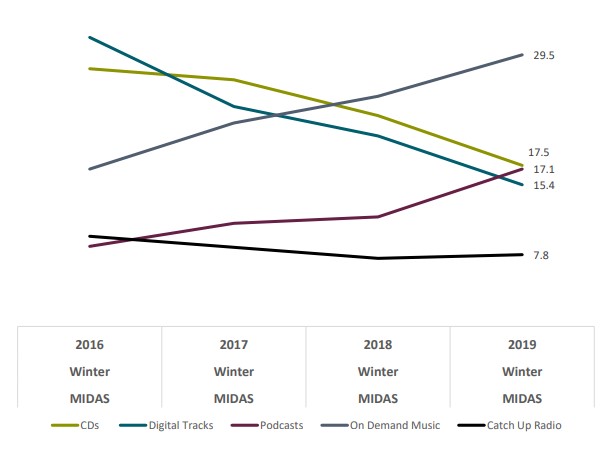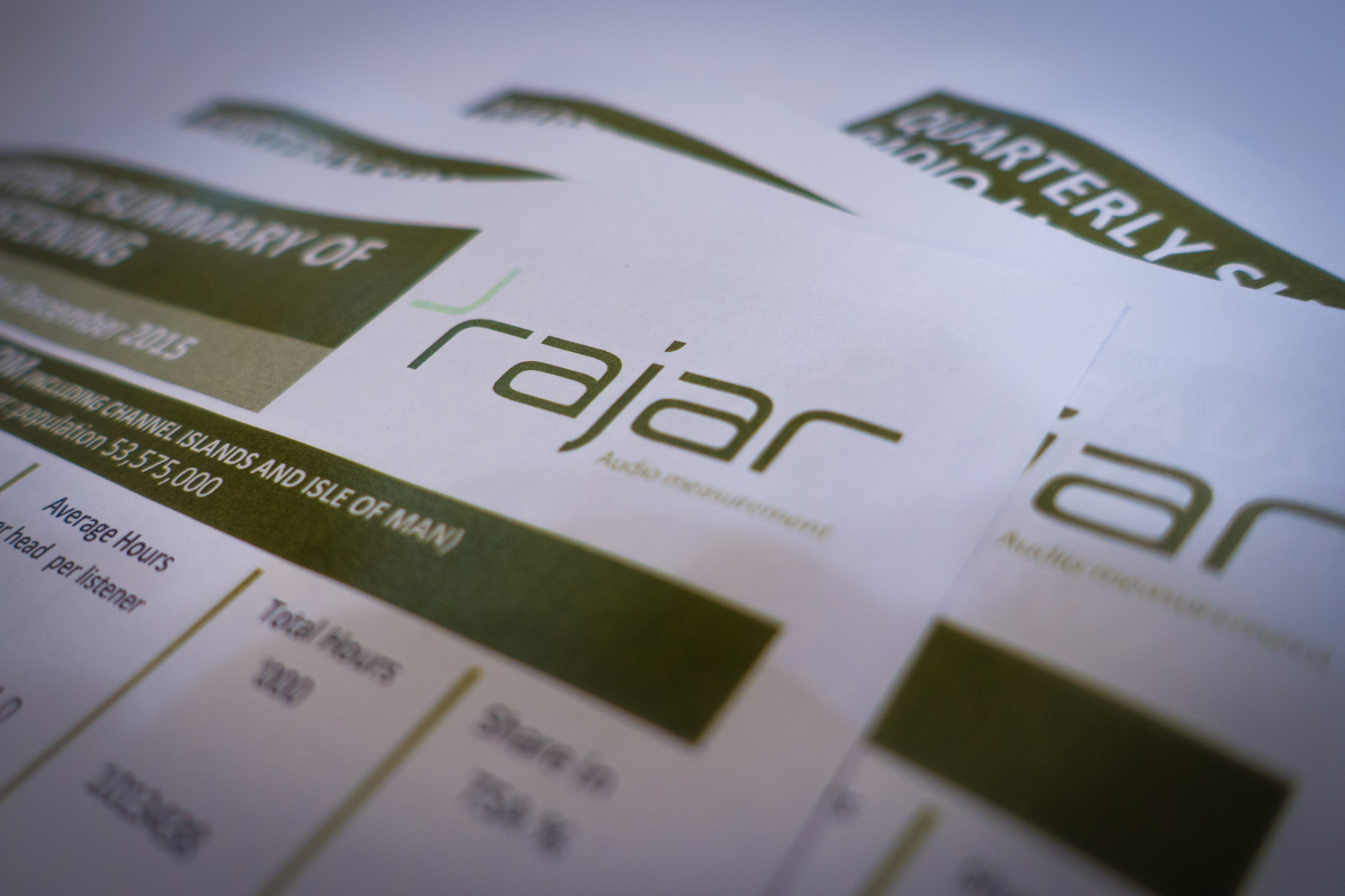This post is brought to you in association with RALF from DP Software and Services. I’ve used RALF for the many years, and it’s my favourite RAJAR analysis tool. So I am delighted that I continue to be able to bring you this RAJAR analysis in association with RALF. For more details on the product, contact Deryck Pritchard via this link or phone 07545 425677.
The latest RAJAR measures the last quarter of 2019, and I think that overall, there are three key stories that come out of this set of figures.
- Youth listening is down again, and commercial radio has been especially impacted this time around.
- Speech radio has done well, probably in no small part due to the December General Election.
- Big commercial networked groups have suffered losses, perhaps in part as a result of them launching a largely successful group of new digital sister stations. But they still end up with net losses.
Let’s look at some of those themes in order, and consider the wider numbers.
Youth Listening and Overall Listening Trends
All Radio listening fell again this quarter, with reach down to 48.1m (down 0.8% on the quarter and down 0.5% on the year). Radio is now listened to by 87% of the population. Still a lot of people, but until recently it was safely around the 90% mark.
Last quarter hours fell below one billion for the first time in a very long time, and they’ve fallen again. They’re down 1.4% on the quarter and down 2.6% on the year to 975.7m hours. Radio listeners now listen for an average of 20.3 hours a week – another decline.
But it’s among the young that the fall is most apparent.
In five years, reach has fallen 11.7%, but hours have fallen 26.5% in the 15-24 category.
That’s not to say that there aren’t challenges within other demos, but this is the most stark one, and is reflected in the results of all the stations that target this demo.
Speech Radio Does Well
A General Election is always good for business amongst speech stations, and it’s perhaps not surprising that all of them have done well this quarter.
BBC Radio 4‘s reach is up 6.1% on the quarter and up 4.7% on the year to 11.0m. Hours are up 7.3% on the quarter and up 4.2% on the year to 117.3m.
BBC Radio Five Live similarly did well this time around with reach up 8.6% on the quarter and up 9.0% on the year to 5.4m. Hours grew to 34.2m up 9.5% on the quarter and up 4.6% on the year.
Even BBC Radio 4 Extra rode the speech growth bandwagon, (perhaps a haven for those looking to escape politics?) with reach up 14.3% on the quarter and up 6.6% on the year to 2.3m. Hours were up 20.8% on the quarter, but down 5.2% on the year to 13.8m.
In the commercial speech sector LBC had another excellent set of results, with reach up 5.6% on the quarter and up 23.3% on the year to 2.7m. Hours rose 0.5% on the quarter and 15.4% on the year to 25.1m.
And Talkradio also had great results, up 5.9% on the quarter and up 43.4% on the year to 433,000. Hours were up 11.5% on the quarter and 93.6% on the year to 2.5m.
Parent company, the Wireless Group has announced that Times Radio will be launching soon. They will be chasing audiences from all of the above.
On Radio 4, the Today Programme (whose editor, Sarah Sands, has announced her departure) had very strong numbers in line with the station, with reach up 8.6% on the quarter and up 5.5% on the year to 7.2m listeners.
Of note is the fact that this is double the combined breakfast audiences of all the other speech radio breakfast shows!
Five Live gets 1.9m (+12.2%/+14.7% on the quarter and year respectively), LBC gets 1.5m (+1.5%/+21.0%) and Talkradio gets 178,000 (+5.3%/+61.8%).
That’s quite a large number of politically invested listeners not hearing Government ministers right now…
Digital Sister Stations Impacting on Parent Brands?
This quarter saw a wealth of new digital radio station launching for the first time. Over the last year Bauer had launched a number, and now it was Global’s turn with Heart Dance, Heart 70s, Hear 90s, Capital XTRA Reloaded, Smooth Radio Country and Smooth Radio Chill all launching. New digital staitons in Manchester (Love 80s Manchester) and Cornwall (Pirate 80s) also launched.
I confess that I didn’t expect all these station to come blasting out the blocks that fast, but I’ve been proven wrong.
Heart Dance has 380,000 reach and 1.8m hours. Heart 70s has 248,000 reach and 0.8m hours, Heart 90s has an excellent 627,000 reach and 2.6m hours, while Capital XTRA Reloaded has 330,000 reach and 1.0m hours. Smooth Radio Chill got 301,000 reach and 911,000 hours, while Smooth Radio Country got 204,000 reach and 1.0m hours.
These are all good results, and that’s a substantial amount of extra listening, but where has it all come from?
Well looking at the performance of the big commercial brands, now largely networked in Global’s case, perhaps gives us a clue.
Capital Brand UK (Which includes all the Capitals and Capital XTRA brands) is down 6.3% in reach and down 8.0% in hours, to 7.6m (from over 8.1m last quarter). Hours are down 11.0% on the quarter and 10.1% on the year to 39.1m (from 43.9m last quarter).
Capital Network UK (which doesn’t include the XTRA brands) is down 7.4% on the quarter and down 9.9% on the year to a reach of 6.5m. Hours are down 10.8% on the quarter and 10.5% on the year 32.4m.
Over at Heart Network UK reach is down 5.7% on the quarter and down 5.4% on the year to 8.1m. Hours are down 8.3% on the quarter and down 12.1% on the year to 50.6m.
When you widen it out to the Heart Brand UK (which includes those digital spin-off services including the new ones) it still registers falls down 2.9% on the quarter and down 2.3% on the year to 9.5m. Hours are down 5.1% on the quarter and down 7.7% on the year to 60.6m.
There are similar stories at the Smooth Brand UK which is down 2.5% on the quarter and down 3.8% on the year in reach to 5.6m. Hours are down 7.8% on the quarter and down 10.4% on the year to 38.5m.
The suspicion must be that the new digital services have seen audiences migrate from some of the local Hearts, Capitals and Smooths to their new digital services, but there’s sill an overall loss (especially those 15-24s).
Elsewhere
Those are my key themes, but let’s run through some of the other key stations’ results.
BBC Radio 1 saw reach and hours both fall. Reach fell 6.0% on the quarter and 6.2% on the year to 8.8m, while hours fell 3.6% on the quarter and down 3.3% on the year to 55.0m.
BBC Radio 2 saw reach rise on the quarter, up 1.8%, but fall on the year, down 3.0%, to 14.4m. Hours followed a similar pattern, up 5.6% on the quarter, but down 8.6% on the year to 166.0m. It’s worth noting that this quarter last year was Chris Evans’ final one.
Speaking of Evans, how did Virgin Radio do? It was up 8.0% on the quarter, and er, 242% on the year to a reach of 1.5m (obviously last year was pre-Evans). Hours rose a respectable 22.1% on the quarter and 485% on the year to 9.9m. I notice another burst of TV advertising at the moment. I still think that Virgin Radio can’t reach especially lofty heights, but the marketing investment keeps coming.
6 Music had a decent set of numbers this quarter, with reach up 3.0% on the quarter and up 8.4% on the year to 2.5m. Hours were up to 23.2m (up 9.7% and 12.9% on quarter and year respectively).
Last quarter BBC Radio 3 had a peculiar set of numbers, but that seems to have righted itself this quarter, with reach up to 2.1m (+10.0%/+16.4% on Q/Y respectively). Hours grew to 14.1m (+10.3%/+18.0%).
Classic FM also had decent numbers with reach growing to 5.5m (+6.3%/+2.9%) and hours up to 40.0m (+1.4%/+9.8%).
Scala saw a bit of growth too with reach up 7.8% to 249,000 and hours up 28.3% to 1.6m. I’m sure Bauer has bigger ambitions for the station however.
Not such great numbers at Talksport which saw its results drift a little. Reach was down to 2.9m (-1.2%/-1.6%), and hours fell to 17.9m (-1.2%/-7.5%). Talksport 2‘s numbers will be better next quarter because of the England cricket tour (which it did have this time last year), so it was more of a holding pattern this time around with reach down a fraction to 324,000 (-0.6%/-0.6%) and hours at 803,000 (+1.3%/-38.2%).
This week, The Guardian had a massive feature highlighting “The Indestructible Appeal of Easy Listening Radio” and focusing on Magic. The station did solidly this quarter with reach down 0.4% on the quarter but up 0.5% on the year to 3.4m. Hours were also a wash up 2.4% on the quarter but down 2.5% on the year to 18.1m.
Across the overall Magic Network reach fell a little to 4.2m (-0.7%/-1.1%), and hours rose to 24.4m (+5.9%/+1.5%).
In line with other youth-leaning stations, Kiss didn’t have the best quarter with reach notably falling a bit to 3.7m (-6.7%/-13.4%) and hours down to 16.0m (-1.3%/-13.4%).
A similar story was true of the Kiss Network with reach falling to 5.3m (-5.1%/-5.3%), and hours falling to 28.0m (-4.3%/-6.5%).
Absolute Radio suffered a little too, down to 2.3m reach (-5.6%/-3.3%) and down to 16.7m hours (-5.0%/-1.5%). Across the Absolute Radio Network things were better with only slight falls on the quarter and growth on the year. Reach was 4.9m (-0.3%/+3.3%) and hours were 34.8m (-1.9%/+3.0%).
Finally slightly mixed results for the Radio X Network with reach down on the quarter but up fractionally on the year to 1.7m (-4.4%/+0.7%), and but hours down to 13.3m (-4.1%/-7.7%).
Finally, we’re at 58.5% of listening via a digital platform. And amongst 15-24s, 21.0% of listening is via the internet. That’s why BBC Sounds, the Global Player, and all the other mobile apps are so important to stations.
One final thing to add is that RAJAR released its separate Winter 2019 MIDAS research last week. There’s lots of good stuff in there, but I thought I’d highlight this chart which shows how different “on demand” types of audio listening have changed.
I would particularly highlight podcast listening which is up to 17.1% of the population or 9.4m a week. That’s quite a sharp up-tick on the year, with podcast listening about to over-take CD listening.

Click on some of the links below for more on breakfast and London.
Further Reading
The official RAJAR site and their infographic
Radio Today for a digest of all the main news
Matt Deegan will have some great analysis
Go to Media.Info for lots of numbers and charts
Mediatel’s Newsline will have lots of figures and analysis
Paul Easton for more lots analysis including London charts
The BBC Mediacentre for BBC Radio stats and findings
Bauer Media’s corporate site
Global Radio’s corporate site
Radiocentre’s take is here
All my previous RAJAR analyses are here.
Source: RAJAR/Ipsos MORI/RSMB, period ending 15 December 2019, Adults 15+. Also of note is that I treat all weekday shows as Mon-Fri except where specified. Some presenters have Friday off, but to compare like with like, I’ve stuck with a five day week.
Disclaimer: These are my views alone and do not represent those of anyone else, including my employer. Any errors (I hope there aren’t any!) are mine alone. Drop me a note if you want clarifications on anything. Access to the RAJAR data is via RALF from DP Software as mentioned at the top of this post.

